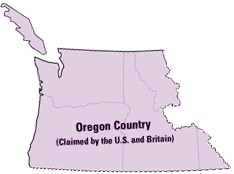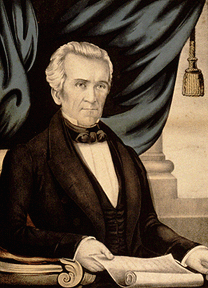|
|
|
The Oregon Question
Introduction - Revival of Expansionism - The Oregon Question - War With Mexico
|
Far to the north and west of Texas, the United States and several other nations vied for the Oregon Country: the land north of California and west of the Rocky Mountains. The territory was variously claimed from the sixteenth century by Spain, Russia, Britain, and the United States. However, by the mid-1820s, only the American and British claims endured. The two nations agreed in 1818 to a "joint occupation" of Oregon in which citizens of both countries could settle; this arrangement lasted until 1846.
|

Map showing region claimed by both the United States and Britain until 1846, including Vancouver Island to the north.
|
The Oregon settlers from the United States and Britain were very different groups. The British were chiefly fur traders associated with the Hudson's Bay Company, while the Americans were a more eclectic lot. American settlement began in the 1830s when Protestant missionaries moved into the Wilamette Valley. Their accounts of the fertile soil of the region spread rapidly to the East and spurred a massive migration of thousands of American families westward along the Oregon Trail. The resulting population disparity along with an overall decline in the fur trade, convinced the British government to work for a negotiated settlement to the Oregon issue.
As with Texas, popular opinion over the Oregon Country was divided. Whereas Texas territory would have added proslavery representation in Congress, any potential states formed from the Oregon Country would be free states. Accordingly, Northerners were the chief advocates of acquiring as much Oregon Country as possible.
James K. Polk and the Policy of Expansion
|
In the presidential election of 1844, Democrat James K. Polk rode to victory over his Whig opponent Henry Clay on an aggressively expansionist platform that welded together the Texas and Oregon issues. Democrats appealed to the expansionist sentiments of both Northern and Southern voters and their shared desire to safeguard the sectional balance in Congress. After winning the election, Polk articulated his foreign policy goals: settlement of the Oregon dispute with Britain, annexation of Texas, and the acquisition of California from Mexico. The acquisition of California represented a significant expansion of American interest in Mexican territory and promised to complicate an already tense Mexican-American relationship over Texas. |

 James Knox Polk James Knox Polk
|
Negotiated Settlement in Oregon
Negotiations between the United States and Britain over the Oregon Country began in the summer of 1845. The initial American proposal called for the boundary to be drawn at the 49th parallel, bisecting Vancouver Island. When British negotiators rejected this proposal, President Polk took a bolder position by reasserting his campaign promise to support the 54° 40' line and announcing the American intent to terminate the joint occupancy agreement within a year. While expansionist Northerners cheered these provocative actions with shouts of "Fifty-Four Forty or Fight!," Southerners in Congress made it clear that they would not risk war with Britain over Oregon.
British leaders were similarly adverse to conflict and did not want to jeopardize their important economic relationship with the United States. In June 1846, the Senate, preoccupied with war against Mexico, quickly approved the Oregon Treaty with Britain, setting the boundary at the 49th parallel.
|


